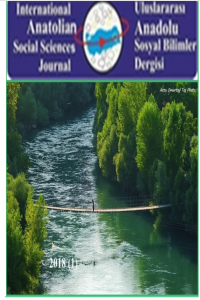BİRİNCİ KÜRESELLEŞMEDEN İKİNCİYE MANCHESTER'IN DEĞİŞEN ROLÜ
Uluslararası Politik İktisat, Küreselleşme, Uluslararası Ekonomi, Ekonomi Tarihi, Manchester
THE CHANGING ROLE OF MANCHESTER FROM THE FIRST GLOBALISATION TO THE SECOND
International Political Economy, Globalisation, International Economics, Economic History, Manchester,
___
- Abell, P. H. (1978). Transport and Industry in Greater Manchester. UK: Barnsley Publishing.
- Baldwin, R., and Martin, P. (1999). Two Waves of Globalisation: Superficial Similarities, Fundamental Differences, in Siebert, H. (ed), Globalisation and Labour (pp. 3 – 59). Tubingen: J. C. B. Mohr for Kiel Institute of World Economics.
- Brown, R. W. (2004). The City in European History: Industrial Manchester in the Nineteenth Century. (Retrieved Date: 12/01/2015): http://www2.uncp.edu/home/rwb/ manchester19c.html.
- Dicken, P. (2015). Global Shift: Mapping the Changing Contours of the World Economy. New York: The Guilford Press.
- Goldsmith, C. (2019). Graphene is the new wonder material transforming the energy sector. (Retrieved Date: 12/1/2019): https://www.theneweconomy.com/energy/graphene-is-the-new-wonder-material-transforming-the-energy-sector.
- Hetheringthon, K. (2007). Manchester’s Urbis: Urban Regeneration, Museums and Symbolic Economies. Cultural Studies, 21 (4-5): 630-649.
- Hirst, P., and Thompson, G. (1996). Globalisation in Question. UK: Cambridge Polity Press.
- Hirst, P., and Thomson, G. and Bromley, S. (2009). Globalisation in Question. UK: Cambridge Polity Press.
- Hodos, J. I. (2011). Second Cities: Globalisation and Local Politics in Manchester and Phil-adelphia. Philadelphia: Temple University Press.
- Kidd, A. (2006). Manchester: A History. UK: Carnegie Publishing.
- Kidd, A.J., and Wyke, T. (2016). Manchester: Making the Modern City. UK: Liverpool University Press.
- Lloyd-Jones, R., and Le Roux, A. A. (1980). The Size of Firms in the Cotton Industry: Manchester 1815-41. The Economic History Review, 33 (1): 72-82.
- Perraton, J. (2001). The Global Economy—Myths and Realities. Cambridge Journal of Economics, 25 (5): 669–684.
- Rodrik, D. (1997). Has Globalisation Gone Too Far?. Californian Management Review, 39 (3): 29- 53.
- Rodrik, D. (2011). Akıllı Küreselleşme (The Globalisation Paradox). Ankara: Efil Yayınevi.
- Taylor, S., and Holder, J. (2008). Manchester’s Northern Quarter: The Greatest Meer Village. UK: English Heritage.
- Vision of Britain (2014). Manchester District. (Retrieved Date: 12/1/2015): https://www.visionofbritain.org.uk/unit/10033007/theme/POP.
- Wadsworth, A. P., and Mann, J. de L. (1931). The Cotton Trade and Industrial Lancashire, 1600-1780. UK: Manchester University Press.
- Wadsworth, A. P., and Mann, J. de L. (1965). The Cotton Trade and Industrial Lancashire, 1600-1780. UK: Manchester University Press.
- Web1: Manchester. http://www.webritish.co.uk/city_display.asp?city= Manchester (Retrieved Date: 12/1/2015)
- Willan, T. S. (1980). Elizabethan Manchester. Manchester: Published for the Chetham Society by Manchester University Press.
- Winterbotham, D. (1998). Sackclothes and Fustyans and Such Like Comodyties. Early Linen Manufacture in the Manchester Region (Occational Paper 38: 22-43). Centre for North West Resgional Studies University of Lancaster.
- Wyke, T. (2016). Rise and Decline of Cottonopolis, in Kidd, A. and Wyke, T. (eds.), Manchester: Making the Modern City (pp. 347-396). UK: Liverpool University Press.
- Başlangıç: 2017
- Yayıncı: Yusuf ARSLAN
ÖĞRETMENLERİN KAPSAYICI İŞLEVİNİN ÖĞRENME İLİŞKİLERİ BAĞLAMINDA NİTEL YÖNTEMLE ARAŞTIRILMASI
M.can HASATEŞ, Özden BADEMCİ, Neslihan ZABCI
ÇAĞDAŞ ALPERENLERDEN ŞEYH OSMAN HÂDÎ (YÜCEBİLGİÇ) EFENDİ’NİN HAYATI
F. Cangüzel GÜNER ZÜLFİKAR, Tuğçe YÜCEBİLGİÇ
Merve UYSAL, Ahmet Erman KARAGÖZ
ÜNİVERSİTELERDE ALTERNATİF YÖNTEMLERLE BİR SERİGRAFİ BASKIRESİM ATÖLYESİ KURULUMU
Erol Murat YILDIZ, Buse KIZILIRMAK
KADIN HAREKETİNDE SOSYAL ÇALIŞMA ÖNCÜLERİNİN YERİ: ALİCE SALOMON ÖRNEĞİ
Beyhan DOĞAN, Havvanur TORAMAN
ERGENLERDE OKUL REDDİ VE SOSYAL DIŞLANMA ARASINDAKİ İLİŞKİNİN İNCELENMESİ
"ÇANKIRI DUYGU GAZETESİ"NDE BULUNAN HİKAYE VE MASALLARDA MOTİF İNCELEMESİ
ÖZEL YETENEKLİ ÖĞRENCİLERE KANUN ÇALGISINI ÖĞRETMEYE YÖNELİK SİSTEMATİK YAKLAŞIMLAR
KRİSHNAMURTİ'NİN EĞİTİM ANLAYIŞI
